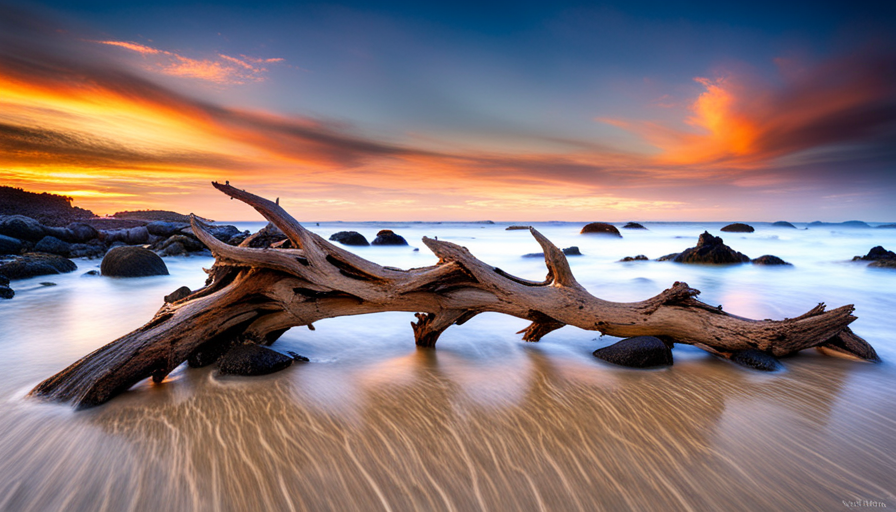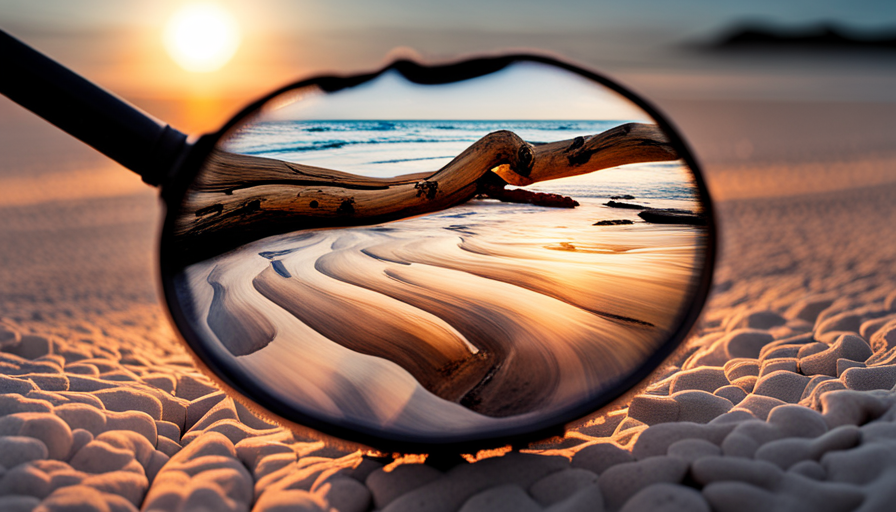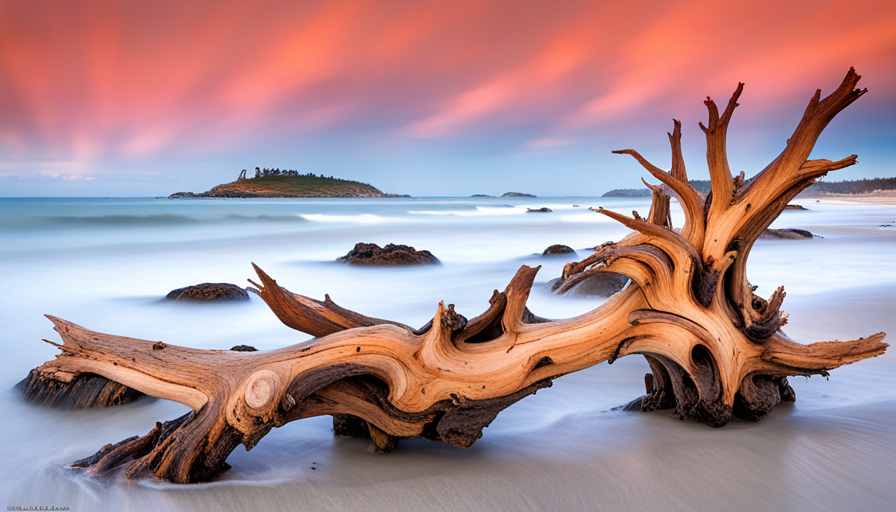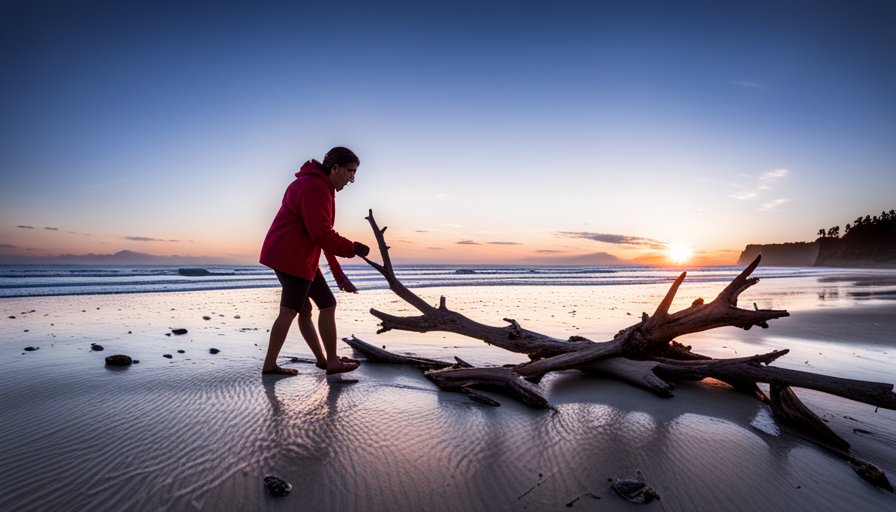Welcome to the world of beach driftwood identification, where each piece of wood tells a unique story of its journey through the vast ocean. Like a detective deciphering clues, you can unlock the secrets of these weathered treasures and unveil the species they once belonged to.
In this essential guide, we will equip you with the knowledge and tools needed to become a driftwood identification expert.
Just as the tides shape the coastline, factors such as water salinity, exposure to sunlight, and the presence of marine organisms leave their mark on driftwood, influencing its appearance. By understanding these factors, you can unravel the mysteries behind the colors, textures, and shapes of the driftwood you find.
Armed with a variety of tools and techniques, you will learn to examine the key characteristics that distinguish one species of driftwood from another. From the distinct grain patterns to the subtle variations in color, your trained eye will discern the secrets embedded within each piece.
Preservation and display methods will also be explored, allowing you to showcase your driftwood collection in all its natural beauty. Furthermore, ethical considerations will guide you in making responsible choices when collecting and utilizing driftwood.
Join us on this scientific and exciting journey, where freedom and exploration await. Unleash your inner detective and embark on a quest to unveil the hidden stories held within beach driftwood.
Key Takeaways
- Driftwood identification is like solving a mystery, unlocking the secrets of its origin.
- Factors like water salinity, sunlight exposure, and marine organisms influence the appearance of driftwood.
- Various tools and techniques can be used to examine the characteristics of driftwood and distinguish different species.
– Understanding the influence of water currents, tides, weathering, erosion, and marine organisms is crucial in interpreting driftwood stories.
Types of Driftwood

Now let’s dive into the different types of driftwood you might come across while beachcombing! Driftwood, often used in driftwood art and driftwood furniture, comes in various forms and shapes.
One common type is the branch wood, which is characterized by its long and slender shape. These pieces of driftwood are perfect for creating unique sculptures or intricate furniture designs.
Another type is the root wood, which is known for its twisted and gnarly appearance. The roots of trees that have fallen into the water eventually wash up on the shore, creating fascinating and organic shapes. Root wood is particularly popular in driftwood art, as it adds a touch of natural beauty to any piece.
Additionally, there is the log wood, which consists of larger pieces of driftwood that can be used to construct larger furniture pieces or even outdoor structures. These logs are often weathered and worn, giving them a rustic and vintage look.
Whether you’re looking to create driftwood art or furnish your beach house, understanding the different types of driftwood will help you find the perfect pieces for your desired projects.
Factors Affecting Driftwood Appearance

When it comes to the appearance of driftwood, there are several factors at play. Firstly, water currents and tides have a significant influence on how driftwood looks. The constant movement and force of the water can shape and sculpt the wood in various ways.
Additionally, weathering and erosion also play a crucial role in determining the appearance of driftwood. Over time, exposure to wind, rain, and other natural elements can wear down the wood, giving it a weathered and aged look.
Lastly, marine organisms contribute to the appearance of driftwood through their interactions with the wood. These organisms can attach themselves to the wood, leaving behind marks and patterns that add to the overall aesthetic of the driftwood.
Influence of water currents and tides
Amidst the turbulent dance of water currents and tides, beach driftwood becomes an elusive storyteller, whispering tales of distant shores and hidden mysteries.
The influence of water currents and tides on driftwood distribution is significant. The movement and direction of water currents determine the path that driftwood takes along the coast. Strong currents can carry driftwood for long distances, while weaker currents may deposit it closer to its origin.
Tides also play a role in the movement of driftwood. During high tides, driftwood may be carried further up the beach, while low tides can leave it stranded on the shore.
Coastal geography, such as the presence of natural barriers or channels, can further affect the distribution of driftwood. Additionally, human activities, such as the construction of jetties or harbors, can alter water currents and disrupt the natural movement of driftwood.
Understanding the influence of water currents and tides is crucial in identifying and interpreting the stories that driftwood has to tell.
Impact of weathering and erosion
Imagine yourself standing on a beautiful coastline, witnessing the powerful impact of weathering and erosion as they shape the landscape before your eyes. The forces of nature, such as wind, rain, and waves, continuously work together to break down rocks and transport sediments.
This relentless action not only alters the physical appearance of the coastline but also has significant ecological implications. As climate change intensifies, the effects of weathering and erosion are becoming more pronounced. Rising sea levels and increased storm activity contribute to accelerated coastal erosion, which threatens the stability of driftwood ecosystems.
Driftwood plays a crucial role in coastal ecosystems, providing habitat for various organisms, acting as a natural barrier against erosion, and even contributing to carbon sequestration. Understanding the impact of weathering and erosion on driftwood ecosystems is essential for preserving these valuable coastal habitats in the face of climate change.
Role of marine organisms
As you stand on the coastline, take a moment to appreciate the vital role marine organisms play in shaping this dynamic environment.
Marine organisms, such as algae, barnacles, and mollusks, have a significant impact on beach driftwood through their activities. Algae, for example, attach themselves to the driftwood, creating a surface for other organisms to colonize. Barnacles and mollusks, with their strong adhesive abilities, further enhance this process by cementing themselves to the wood.
These organisms not only help to break down the driftwood into smaller pieces, but they also contribute to the overall ecosystem dynamics. By providing a habitat for other organisms, the presence of marine organisms on driftwood supports biodiversity and promotes the exchange of nutrients and energy within the coastal ecosystem.
So, next time you come across a piece of driftwood on the beach, remember the important role that marine organisms play in shaping this coastal landscape.
Tools and Techniques for Identification

Using a magnifying glass and tweezers, beachcombers can meticulously examine the unique textures and patterns of driftwood to identify its origin. These tools and techniques are essential in distinguishing between different types of wood and understanding the journey it took to reach the beach.
The first step in identification is to carefully observe the color, grain, and bark of the driftwood. This can provide clues about the species of tree it came from and the type of environment it grew in.
Next, beachcombers can use a magnifying glass to examine the surface of the wood for signs of weathering, such as cracks, erosion, or insect damage. These characteristics can indicate how long the driftwood has been in the ocean and the conditions it has endured.
Additionally, tweezers can be used to extract small fragments or fibers from the wood for further analysis. By comparing these samples to reference materials or conducting chemical tests, beachcombers can determine the specific type of wood and even the region it originated from.
However, it’s important to avoid common mistakes, such as relying solely on visual observations or assuming that all driftwood comes from nearby shores. By utilizing these tools and techniques, beachcombers can unlock the secrets of driftwood and gain a deeper understanding of its fascinating journey.
Identifying Driftwood Species

When identifying driftwood species, it’s important to consider the characteristics of different types of wood. Pine, cedar, and fir are commonly found in coastal areas and can be identified by their light color and straight grain.
Oak, maple, and birch are also frequently encountered and can be distinguished by their distinct grain patterns and varying shades of brown.
Additionally, tropical hardwoods and exotic species may be present, characterized by their unique textures and rich colors.
Pine, cedar, and fir
One quick way to enjoy the beach even more is by learning to identify pine, cedar, and fir driftwood. These three species of wood can often be found washed up on the shore, and being able to identify them can enhance your beachcombing experience.
Here are three key characteristics to help you identify pine driftwood:
- Look for needles or pinecones still attached to the wood.
- Observe the color and texture of the bark, which is often reddish-brown and rough.
- Notice the distinct scent of pine when you scratch or break a small piece of the wood.
To identify fir driftwood, consider the following:
- Look for small, flat needles that are softer to the touch.
- Notice the smooth and grayish bark.
- Pay attention to the wood’s fragrance, which is often mild and pleasant.
For cedar driftwood identification, keep these points in mind:
- Look for thin, scale-like leaves attached to the wood.
- Notice the reddish-brown or yellowish color of the bark.
- Recognize the strong, distinct aroma of cedar.
By familiarizing yourself with these characteristics, you’ll be able to confidently identify pine, cedar, and fir driftwood during your beach adventures.
Oak, maple, and birch
Now that you’ve learned about the distinct characteristics of pine, cedar, and fir driftwood, let’s delve into another set of common beach driftwood: oak, maple, and birch. Identifying oak driftwood can be quite straightforward due to its unique grain pattern and density. Oak wood is known for its durability and strength, making it a popular choice for furniture and construction.
When it comes to birch driftwood, its distinctive bark sets it apart from other types. Birch wood has a smooth, papery bark that can peel off in thin layers. This wood is often used for crafts and decorative purposes due to its attractive appearance.
By familiarizing yourself with the specific traits of oak and birch driftwood, you’ll be able to spot them easily during your beachcombing adventures.
Tropical hardwoods and exotic species
To identify tropical hardwoods and exotic species, you can easily distinguish them by their vibrant colors and unique patterns, such as the deep red hue of padauk or the intricate grain of zebrawood.
Exotic timber, sourced sustainably, offers a wide array of options for those seeking freedom in their beach driftwood collection. One such example is teak, known for its durability and resistance to decay. Its golden-brown color and straight grain make it a popular choice for furniture and outdoor decking.
Another exotic species to look out for is purpleheart, which boasts a stunning purple color that deepens with age. This dense and durable wood is often used in fine woodworking and decorative applications.
By understanding the characteristics of these tropical hardwoods and exotic species, you can enhance your beach driftwood collection with unique and sustainable pieces.
Preservation and Display

Preserve and showcase beach driftwood like a pro with these essential tips.
When it comes to preserving your precious finds, there are several techniques you can employ. One common method is to clean the driftwood by scrubbing it gently with a brush and mild soap to remove any dirt or debris. After cleaning, you can choose to treat the wood with a wood stabilizer or sealer to prevent further decay and protect it from the elements.
Another popular preservation technique is to bleach the driftwood to lighten its color and enhance its natural beauty. This can be done by soaking the wood in a mixture of water and bleach for several days, followed by rinsing and drying thoroughly.
Once your driftwood is preserved, it’s time to get creative with its display. There are countless ways to showcase your collection, depending on your personal style and preferences. You can create a stunning centerpiece by arranging driftwood pieces in a glass vase or jar, adding sand and seashells for a beachy touch. For a more rustic look, consider building a driftwood shelf or table, using the wood as the main material. If you’re feeling particularly artistic, you can even use the driftwood to create sculptures or wall hangings. The possibilities are truly endless.
Preserving and displaying beach driftwood is a rewarding and enjoyable process. By following these preservation techniques and exploring creative display ideas, you can transform your driftwood into stunning pieces of art that capture the essence of the beach and bring a touch of freedom and nature to your home.
Ethical Considerations

Ensure you’re making ethical choices when collecting and displaying your beach driftwood treasures. Ethical considerations are crucial to protect the environment and preserve the beauty of our beaches.
When collecting driftwood, keep in mind the potential environmental impact and follow these guidelines:
- Respect local regulations: Before collecting driftwood, familiarize yourself with any rules or regulations in place to protect the beach ecosystem. Some areas may have restrictions on taking natural materials from the beach.
- Collect responsibly: Only gather driftwood that’s already detached or washed ashore. Avoid damaging live trees or disturbing wildlife habitats in the process.
- Leave no trace: When collecting driftwood, be mindful of the environment and avoid leaving any trace behind. Remove any trash or debris you may come across while collecting.
- Sustainable sourcing: Consider the source of the driftwood. Choosing driftwood from sustainable sources, like reclaimed materials or driftwood already destined to be discarded, can help minimize the environmental impact.
- Display with care: When displaying your driftwood treasures, ensure they’re properly cleaned and treated to avoid the introduction of invasive species or pests. Use natural, eco-friendly finishes and avoid chemicals that could harm the environment.
By following these ethical considerations, you can enjoy your beach driftwood collection while also protecting the environment for future generations to appreciate.
Frequently Asked Questions about Driftwood Identification

Are you curious about how long it takes for driftwood to form? Well, according to scientific research, the process of driftwood formation can vary widely depending on environmental factors such as water temperature, currents, and the type of wood. On average, it can take several years for a piece of wood to transform into driftwood through natural processes of erosion and weathering.
If you’re considering using driftwood for crafting, you’ll be pleased to know that it can indeed be a valuable resource. Driftwood’s unique shapes and textures make it a popular choice for creating various artistic and functional pieces. Whether you’re into sculpting, woodworking, or even jewelry making, driftwood can add a natural and rustic touch to your creations.
While most driftwood may not hold significant monetary value, there are rare and valuable types that collectors and enthusiasts seek out. Some examples include root driftwood, which is prized for its intricate and gnarled appearance, and driftwood from exotic tree species like teak or mahogany. These rare finds can fetch a higher price due to their scarcity and unique characteristics, making them highly sought after by collectors and designers alike.
How long does it take for driftwood to form?
Driftwood takes several years to form, creating unique and fascinating pieces that wash up on our shores. The formation time of driftwood can vary depending on various factors.
One of the main factors influencing the formation of driftwood is the type of wood. Softwoods, such as pine and cedar, tend to break down more quickly than hardwoods like oak and mahogany.
Additionally, the environment in which the wood is exposed to plays a significant role. Exposure to saltwater, wind, and waves can accelerate the breakdown process, while wood in freshwater environments may take longer to form driftwood.
Other factors such as temperature, currents, and the presence of bacteria and fungi also contribute to the formation time.
Overall, the process of driftwood formation is a complex one that requires time and specific conditions to create the beautiful and weathered pieces we find on the beach.
Can driftwood be used for crafting?
Crafting with driftwood opens up a whole new world of creative possibilities, allowing you to transform these weathered treasures into unique and charming pieces for your home. Driftwood crafting ideas are endless, and the benefits of using driftwood for crafting are numerous. Here are some ideas to get your creative juices flowing:
- Driftwood mobiles: Create a beautiful and rustic mobile by stringing together different pieces of driftwood, adding shells, and hanging it near a window or in a garden.
- Driftwood picture frames: Add a touch of nature to your favorite photos by framing them with driftwood. The irregular shapes and textures of the wood will give your pictures a one-of-a-kind look.
- Driftwood candle holders: Hollow out a piece of driftwood and place a candle inside for a natural and cozy centerpiece.
- Driftwood wall art: Arrange different lengths and shapes of driftwood onto a canvas or wooden board to create a stunning piece of wall art.
Crafting with driftwood not only allows you to unleash your creativity but also benefits the environment by repurposing natural materials that would otherwise go to waste. So go ahead, explore the world of driftwood crafting and let your imagination run wild.
Are there any rare or valuable types of driftwood?
Discover the hidden treasures of rare and valuable driftwood that’ll leave you in awe of their unique beauty.
The world of driftwood offers a plethora of rare species that are highly sought after by collectors and enthusiasts. One such species is the Manzanita driftwood, known for its intricate and twisted branches that add a touch of elegance to any craft or decor.
Another valuable find is the Redwood driftwood, prized for its rich reddish-brown color and durability. These rare driftwood species aren’t only visually stunning but also highly coveted in the valuable driftwood market.
Collectors and artists alike are willing to pay a premium price for these exceptional pieces, making them a lucrative investment opportunity. So, if you stumble upon one of these rare treasures during your beachcombing adventures, consider yourself fortunate and embrace the freedom to explore the potential they hold.
Frequently Asked Questions
Can I use any type of wood I find on the beach for crafts and projects?
You’re in luck! Any type of wood you find on the beach can be used for crafts and projects. Beach wood crafts and projects allow you the freedom to explore your creativity and create unique pieces.
How can I tell the age of a piece of driftwood?
To determine the age of driftwood, examine its weathering effects, such as cracks, erosion, and color changes. These indicators can give you an idea of how long the wood has been exposed to the elements.
Are there any health risks associated with handling driftwood?
Handling driftwood may pose health risks due to potential exposure to harmful bacteria, fungi, and chemicals. It is important to wear gloves, wash hands thoroughly, and avoid inhaling dust or fumes to protect yourself.
Can driftwood be treated or sealed to prevent further decay?
To prevent further decay, you can treat and seal driftwood using various methods. From chemical treatments to natural oils, there are plenty of options available to preserve its beauty and extend its lifespan.
Are there any regulations or laws regarding the collection of driftwood from beaches?
There are regulations on driftwood collection, which vary by location. It is important to consider the environmental impact of collecting driftwood, as it provides habitat for organisms and plays a role in beach erosion.
Conclusion
In conclusion, identifying beach driftwood is a fascinating and intricate process that requires careful observation and knowledge of various factors. By understanding the different types of driftwood and the factors that affect their appearance, you can become proficient in identifying driftwood species. Utilizing the right tools and techniques is essential for accurate identification.
Remember, preservation and ethical considerations are crucial when collecting and displaying driftwood. As the saying goes, “The devil is in the details,” and this rings true when it comes to the art of driftwood identification.
Happy exploring!

